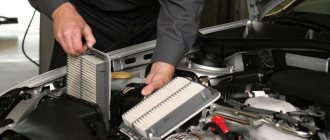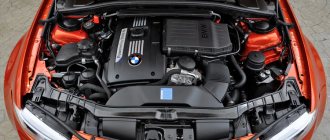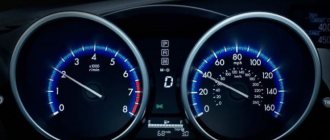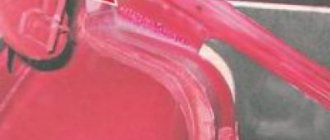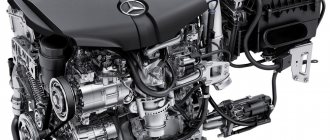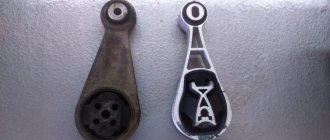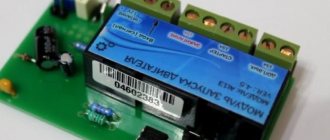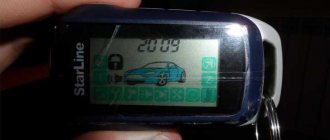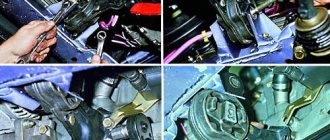If you do not yet have experience in disassembling and assembling a motor, but have a desire to try it, then this article will help you. We will tell you the procedure and note the main nuances that should be taken into account when performing this work.
First, let's prepare everything you need: new gaskets or sealant for the internal combustion engine, a torque wrench, a set of wrenches of different sizes, and you will need open-end, ring and socket wrenches with interchangeable heads, long and short wrenches. Take into account the fact that you will have to spend a lot or a lot of time on the work (depending on the model and condition of the motor, disassembly takes from several hours to several days).
To disassemble the engine, it must first be removed. Before doing this, drain the oil and coolant and remove all attachments. Advice: it is better to put the bikes and units from each unit separately, or even better - in labeled boxes.
Disassembly of an internal combustion engine usually occurs in the following order:
1. Disconnect the gearbox (just unscrew the bolts).
2. Disconnect the clutch (again, unscrew the bolts that secure the casing and remove the entire assembly).
3. Remove the crankshaft pulley. We screw the bolt into the mounting hole, place a flat-head screwdriver between the teeth of the flywheel, and press it against the bolt. Then use a gas wrench to unscrew the nut (or ratchet), use something (for example, a wheelbrace) to pry up the pulley and remove it.
4. Remove the flywheel (just unscrew the bolts); underneath there is a plate held in place by bolts - remove that too.
5. Remove the timing belt or chain from the camshaft. In some cars there are still obstacles on the way to this element. Sometimes in the form of a front engine cover (attached with nuts on studs), sometimes in the form of a cylinder head cover (fastened with nuts or bolts).
To remove the chain, remove the tensioner from it, then unscrew the camshaft gear and then remove the belt (chain) itself.
Next in line is the crankshaft gear. If you have a special puller, this will speed up the work, because... This gear is secured with a key. If during the work you slightly damage the edges of the key, you can correct them later with a file. Lastly, remove the chain tensioner shoe.
6. Dismantle the camshaft (unscrew the nuts that hold its casing and take out the shaft itself).
7. Remove the cylinder head, which is held in place by bolts or nuts on studs.
After this stage, the motor can be turned over and the pan can be removed (there will be a gasket under it).
8. Remove the oil pump. We unscrew the rear oil seal cover, unscrew the bolts, remove the retaining bracket and use a screwdriver on the back of the engine to remove the pump shaft and its drive gear. Be especially careful, this part is very important in the operation of the internal combustion engine!
9. Next you need to be no less careful - we dismantle the crank mechanism.
10. The next stage is the removal of the connecting rods. First of all, we turn the crankshaft so that the two connecting rods are in the upper position. Then unscrew the nuts and remove the yoke (the lid fits tightly, you will have to help yourself with a hammer, only carefully). We push out the connecting rod along with the piston. We do this with all connecting rods. It is better to put the covers in place, this will simplify assembly later (the numbers of the covers and connecting rods must match).
11. Remove the main covers by unscrewing the nuts that secure them.
12. We take out the crankshaft, remove the old bearings and retaining half rings.
Congratulations: the engine is disassembled!
As you might guess, the power unit is assembled in the reverse order. But here it is important to consider some points:
Detailed instructions for disassembling and repairing the VAZ 2110 engine:
2. Remove the clutch from the engine.
3. Remove the tension roller, camshaft drive belt and spacer washer, which is installed under the tension roller.
4. Remove the toothed pulley from the camshaft.
5. We unscrew four bolts, three of which attach the water pump. Unscrew the fastening nut on the rear cover of the camshaft drive belt and remove the cover.
6. To remove the water pump, insert a screwdriver between the block and the flange of the pump housing and thus move it from its seat. After completing these operations, remove the water pump.
7. Remove the head from the cylinder block.
8. Unscrew the bolts (there are 16 of them) securing the oil sump, then remove it together with the gasket.
9. Unscrew the bolts (there are 3 of them) securing the oil receiver and remove it. Please note that there are spring washers under the bolt heads.
11. Then rotate the crankshaft so that the piston that is being removed hits BDC (bottom dead center). It is necessary to unscrew the two fastening nuts to remove the connecting rod cover.
12. Now remove the connecting rod cover. In cases where it is difficult to dismantle the cover, you can first remove it with light blows of a hammer. It may be that the cylinder number on the cap will not be visible, in which case the cap should be marked with the cylinder number.
13. Using the handle of a hammer, push the connecting rod inside the cylinder, then carefully remove the piston and connecting rod from the cylinder. During the process, you need to make sure that the lower head of the connecting rod does not touch the cylinder mirror, since this can damage it. We remove the remaining pistons in the same way.
14. If you need to remove the piston from the connecting rod, then mark it with the cylinder number so as not to confuse them when installing them. There should also be a cylinder number on the connecting rod: if it is not visible, then we mark the connecting rod as well.
16. Unscrew the bolts (there are 6 of them), remove the crankshaft rear oil seal holder and the gasket. Remember that there are spring washers under the bolt heads.
17. Remove the toothed pulley from the crankshaft. If the key does not fit tightly in the groove of the shaft elbows, be sure to remove it so that it does not get lost.
18. Unscrew the six bolts, under the heads of which there are spring washers, and remove the oil pump and gasket.
19. We unscrew the mounting bolts on the five covers (each with 2 bolts) of the main bearings.
20. Remove the covers.
21. Remove the crankshaft of the VAZ 2110 car.
22. We remove the crankshaft thrust half-rings on the middle support.
23. If you do not plan to replace the liners, then as you remove them, remove them from the block beds and from the main bearing caps.
24. On the non-working side we mark the liners relative to the beds and covers.
Extraction from the top
If you have a good winch or 3-4 reliable assistants, then there is no better solution on how to remove the engine from the VAZ 2114 through the top. This method differs from removal through the bottom in that it eliminates the possibility of damaging the engine itself or the car. The most important factor in the success of this operation will be your accuracy.
Removing the engine from the top
The procedure for removing the engine from the top must be carried out as carefully as possible. It is important to take into account everything that can affect the engine falling off its mounts. Moreover, if you do everything correctly, this method will be the least labor-intensive. At its core, this procedure is no different except for removal from removing an engine without a gearbox.
Engine care, driver actions to extend the “life” of the engine
To extend the life of the engine, it is necessary to create the most gentle operating conditions for it, try to maintain optimal engine speeds and use only technical fluids recommended by the manufacturer, in particular, high-quality oil and fuel.
Timely oil change: the most important procedure
In addition, regularly carry out various preventive measures and do not forget to take good care of your car.
Major overhaul, which indicates the need for a major overhaul of the engine
The cylinder parts can tell you that your vehicle's engine needs a major overhaul. This is noticeable by the car’s greater need for oil - consumption is more than one liter per thousand kilometers.
What does the color of the exhaust gases mean?
A clear sign of engine trouble is the presence of characteristic bluish smoke from the exhaust pipe. However, when these symptoms appear, you should not rush to conclusions.
Oil leak
For example, high oil consumption may indicate that the valve stem seals have lost their elasticity.
Check out our article on replacing valve stem seals. 3drive has created complete and most understandable instructions about this procedure.
We believe that even inexperienced motorists can roughly understand what this can lead to:
- increased oil consumption (it simply burns along with the fuel mixture);
- inefficiency of the engine (oil + fuel + air does not provide the efficiency expected from the engine);
- destruction of the cylinder-piston group (and it’s good, if the matter is resolved by rupture of the rings, the pistons can often burn out and then the costs will be tens of times higher than preventive ones).
Due to the high temperature (and the engine heats up to very high temperatures during operation), the rubber from which the oil seals are made hardens, the part loses its elasticity, becomes rigid and no longer fits tightly around the valve stems. Because of this, oil gets inside.
The crank mechanism should be highlighted - a characteristic knock is possible, indicating complex damage to the bearings, crankshaft liners and other sliding components. You can diagnose a knock using a stethoscope, and a pressure gauge can help determine the pressure in the cylinders. Serious signs that a major engine overhaul will be needed in the near future include the following symptoms: increased fuel consumption, loss of power, increased engine noise.
If you find most of the signs listed above in your car, then most likely you cannot avoid capital damage. However, to be more certain whether a major overhaul of the engine is required or not, it is better to contact a special service station, where they will check the degree of wear of all engine elements. For this check, special devices are used at stations - bore gauges, dial indicators, micrometers, measuring clamps. Using these devices, you can accurately determine the need for engine repair.
Compression test, troubleshooting
One of the main reasons for engine repair is decompression. Actually, the troubleshooting itself must be done every 30 thousand km, combining it with valve adjustment.
Signs of the need for early technical inspection of the engine are:
- power surges;
- increase in fuel consumption;
- engine tripping.
Compression measurement
If you experience similar symptoms, you need to do the following:
- Check the starter and charge the battery.
- Find a compression gauge and warm up the car.
- Remove the spark plugs and fuel supply hose.
- Insert the compression gauge into the spark plug socket of the first cylinder and depress the accelerator.
IMPORTANT! The normal pressure in the VAZ 2114 engine is 1.0 MPa in the standard configuration and 1.4 MPa on an eight-valve engine.
- We turn the key in the ignition and turn the starter for 10 seconds, watching the device, it must be interpreted as follows: a. if the pressure stops at 0.8 mPa and then stops growing or does so slowly, then the cylinder head is broken or there is a leak in the valve; b. if it just grows slowly, it means that the rings have exhausted their service life (by the way, this fact can be checked by adding oil and measuring again, if the pressure returns to normal - the rings are 100% to blame).
After the procedure is repeated for all cylinders, it is necessary to analyze the records. So, in a working engine, compression should not fall below 1 MPa and should not have a spread between the cylinders of more than 0.2 MPa. Otherwise, you will have to repair the engine.
Trust the professionals, or do the repairs yourself
Many drivers think that doing major engine repairs on their own is much cheaper than contacting specialists at a service station. However, this is not always a correct statement. For example, in some situations, it is necessary to grind and polish the cylinder mirrors or replace the piston rings. It is very difficult to carry out such operations at home. In addition, it is necessary to have special devices, which, as a rule, are quite expensive. Therefore, in this case, it is advisable to seek the help of professionals.
Gas distribution mechanism
Comprises:
— camshaft;
- intake and exhaust valves.
Camshaft
As a rule (in modern cars) it is located in the upper part of the cylinder head.
An integral part of the camshaft are its cams. There are exactly as many of them as there are intake and exhaust valves. These cams, pressing on the valve pusher lever, open it, and “running away” from the lever, the valve closes under the action of the return spring.
camshafts
Spare parts for engine overhaul
To overhaul the engine you will need the following spare parts:
- Water pump.
- Oil pump.
- Fuel pump.
- Guide bushings and valves.
- Sets of gaskets and seals.
- Asterisks.
- Piston rings.
- Bushing inserts.
- Chain.
- Belts.
And this is not a complete list of all the parts you will need.
It is advisable to first disassemble the motor and pay attention to the elements that actually require replacement. And only after that start purchasing the necessary spare parts. If you decide to contact a car service, then after diagnostics the specialists will tell you what elements need to be purchased for subsequent replacement.
Expert commentary
Victor Lelikov,
employee :
Spare parts for VAZ engines are in good demand. This is why there is such a high proportion of substandard spare parts on sale. Such parts come from three sources. The first is cooperative spare parts: their use is especially dangerous. For example, the service life of timing belts can be only a few tens of engine hours. The second source is still encountered defects from the official supplier. This is a spare part that did not pass VAZ technical control, but went on sale. Such parts and components destroy buyers’ faith in the reliability of VAZ cars. Finally, the third source is remanufactured engine parts. But these are becoming less and less common.
Engine disassembly, DIY repair and diagnostic manual, step-by-step instructions
There are no standard instructions on how to overhaul an engine. It all depends on the specific make and model of your vehicle and the wear and tear of various engine components.
In any case, for major repairs it is necessary to completely disassemble the engine. This process is long and labor-intensive, which cannot always be done at home.
Removing the power unit
For those who are not afraid of difficulties, we have prepared a short guide to engine overhaul:
- First, we remove the engine from the vehicle. To make your car's engine a little lighter, you need to dismantle some units - we start with the carburetor, then remove the cylinder head cover, dismantle the generator, disconnect the gearbox, dismantle the manifold, and then remove the flywheel and clutch. Now you can unscrew the cushions and remove the engine.
- To gain access to the crankshaft and pistons, you need to remove the crankcase cover. Then we unscrew the connecting rods. We take out the pistons and remove the pins from them. Now you need to remove the crankshaft and its bearings.
- Pay special attention to wear on the crankshaft liner and journal. If necessary, bore them. In addition, do not forget to purchase piston rings, pins and new liners.
How to remove the engine from a car in the garage without resorting to the help of a car service
In fact, this is not such a complicated procedure as it might seem at first glance. The main task is to select tools for removing the motor.
Important! The engine weighs several hundred kilograms. Falling it can not only cause property damage, but also lead to serious injuries. Before lifting the engine from the engine compartment, the following procedures must be carried out:
Before lifting the engine from the engine compartment, it is necessary to carry out the following procedures:
- Drain all technical fluids: oil, power steering fluid, brake fluid.
- Free the cooling system from antifreeze.
- Drain the gearbox (except when you remove the engine without removing the gearbox).
- Disconnect all hoses and pipes of the fuel, brake, lubrication and cooling systems.
- If possible, remove attachments: air conditioning compressor, generator, etc.
- Disconnect electrical cables, engine control unit, injector control cables, high-voltage ignition coil wires.
- Remove the connectors from all motor sensors. It is recommended to make a list (“based on” the maintenance and repair instructions), this will help you not to miss a hidden connector.
- In most cases, you will need to remove the hood cover.
If you plan to remove the engine without the transmission, you need to unscrew all the tightening bolts and make sure that after removal the gearbox will not fall under the car. That is, you need to take care of temporarily securing the unit.
Engine assembly, step-by-step instructions
Assembling the motor involves the following steps:
- You should start from the moment where you finished disassembling the engine. Before installing the crankshaft back, it is necessary to replace the old bearings and thoroughly treat the new ones with oil. Don't confuse them.
- Then you need to heat the connecting rods in oil and carefully insert new pins into the pistons. Next, we put on new rings - put on the oil scraper ring first, then the second compression ring, then the first compression ring. You should put the rings on as carefully as possible so as not to damage them. Be especially careful when putting on the second compression ring because it is made of cast iron.
- Now we install the finished pistons into the cylinder block. For this you need a mandrel. If you don't have one, you can make your own mandrel. To do this, take a tin strip to wrap it around the piston head and clamp the mandrel with pliers. After this, we adjust the optimal position of the connecting rod and slowly mount the piston in place.
- We return the crankcase cover to its place and install the engine in the vehicle. We tighten the cushions, install the flywheel and clutch, and mount the gearbox. We return the manifold, cylinder block cover, generator and carburetor to the car.
- We turn the crankshaft several times and, if the battery is fully charged, start the engine.
Connecting rod and piston group
When disassembling the connecting rod-piston group, it is recommended to secure the connecting rod assembly with the piston in a vice, remove the piston rings using the device, and remove the piston pin retaining rings with pliers. When removing the oil scraper ring, you must use a tool to remove the ring disks, then manually remove the expanders. To press out the piston pin, heat the piston in oil or in an electric heater to a temperature of 55 ° C, press out the piston pin using a mandrel and disconnect the piston from the connecting rod. Then you need to check the condition of the piston pin, piston and bushings of the upper end of the connecting rod.
Running in the engine, advice from professionals
After repairs, you should not subject the vehicle to high loads. First you need to warm up the engine well. Then start the engine and let it idle for about ten minutes. After this, the engine must be turned off and cooled. These manipulations should be done several times. The engine should now idle for about ten hours. Only after the above operations can you begin operating the vehicle.
For the first fifty kilometers of driving, you should not accelerate the vehicle more than forty kilometers per hour. Then it can be accelerated to 60 km/h. Then, every hundred kilometers you drive, you need to increase the speed of the car by 10 km/h. Notice the increase in compression level. If it is missing, send the vehicle for re-diagnosis. Try not to accelerate or brake suddenly.



